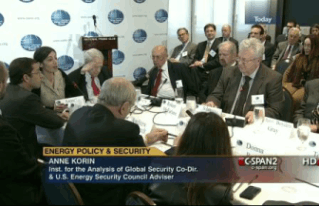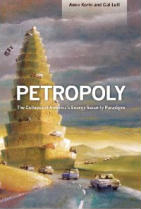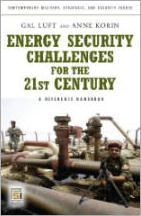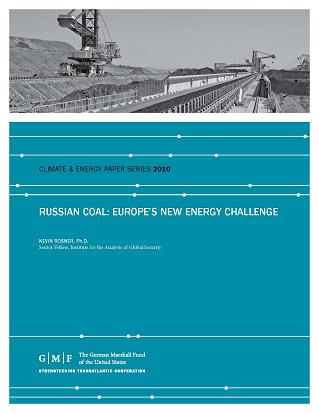Taken together, the six nations of Central America count a population of roughly 40 million people and an energy market equal in size to that of Colombia. The entire region has struggled to achieve a reliable and cost-competitive supply of energy and is a net importer of hydrocarbons. According to data from the Energy Organization of Latin America (OLADE), electricity represents 35% of total demand from primary energy sources in Central America. But perhaps most importantly, the region’s electric generation mix has gone from 66% hydropower, 30% thermal, 4% renewables in 1990 to 41% hydropower, 47% thermal, 13% renewable in 2008. The region is therefore increasingly exposed to oil market volatility as the preponderance of thermoelectric generation depends on imported fuel oil and diesel as feedstock. Indeed, there are currently no natural gas-fired power generation plants operating in Central America.
Across the six nations, the electric sector and market structure differ greatly from fully competitive wholesale markets to monopoly integrated utilities acting as single buyer. The region is divided into six sub-markets, each with different levels of economic development, energy infrastructure and energy preferences. But Central America’s electric market has the potential to benefit from economies of scale. Indeed, in the long-term Central America would be best served by a single regional market.
Incremental progress has been made from reforms in the 1990’s to an important regional energy interconnection project – the Central American Electrical Interconnection System or SIEPAC for its name in Spanish. A fundamental SIEPAC goal and challenge is to set up a regional market and regulatory system, one where political intervention assists rather than impedes integration.
The potential benefits of electric integration in Central America have long been touted, particularly the economies of scale that may be facilitated as larger electric generation projects aim to tap into a regional market as opposed to being constrained by smaller, national boundaries.
Efforts to date have centered on the interconnection of the region’s electric grid and the SIEPAC project. The project, formalized in the "Tratado Marco del Mercado Eléctrico de América Central" (Treaty) includes a roughly 1,800 kilometer electric transmission line project that is almost complete. Upon completion, the project will run from Panama to Guatemala and physically interconnect the electric systems of all the countries of Central America.
The Treaty also spells out the creation of a 7th electric market, a regional market known by its Spanish acronym, the MER, that will permit exchanges of electric power across the existing six markets using the SIEPAC transmission infrastructure. The importance of the treaty must be underscored both for its relatively momentous advance for Central America’s political environment but more importantly for it provides the legal foundation on which the foregoing institutional and physical infrastructure are based.
After many years of development, SIEPAC is poised to open a new chapter in Central America's electric infrastructure and market. But hurdles remain, particularly with regards to the development of the regional electric market and political issues surrounding the project, as well as security concerns and local conflicts that are increasingly impinging upon the energy sector. While not necessarily a hurdle, the role of conservation and efficiency and improved utilization of energy resources in Central America must also be considered in a discussion of the region’s electric scene.
SIEPAC background & regional electric treaty
The Central American Electrical Interconnection System (SIEPAC) is a roughly 1,800 kilometer electric transmission line project that will run from Panama to Guatemala and interconnect the electric systems of all the countries of Central America. The project will consist of 15 substations and 230KV high tension transmission lines that will allow for capacity of 300MW in both directions at the outset but will also include tower infrastructure to enable a future second circuit. Of the approximately 1,800 kilometer length of the project, the countries of Central America will have the following respective segments of the SIEPAC project: Guatemala: 282 km; El Salvador: 287 km; Honduras: 270 km; Nicaragua: 309 km; Costa Rica: 489 km; and Panama: 151 km. (See Figure 1).
Figure 1: SIEPAC Project Map and Basic Characteristics

Source: Empresa Proprietaria de la Red
While the project has been hyped for many possible advances in Central America ranging from lower electricity costs for consumers in the region to improved security of supply, the project has two specific goals: 1) Support the formation and consolidation of a Regional Electric Market (MER) through the creation and establishment of the institutional, legal and technical mechanisms to facilitate the participation of the private sector in the development of increased electric generation capacity; and, 2) Establish the infrastructure for electric interconnection (transmission lines, substations, etc) that permit the exchanges of electric power among the participants of the MER. Moreover, the project and effort are firmly guided by the aforementioned Treaty signed by all six Central American nations in 1996 and specifically its three key principles of gradualness, reciprocity, and competition. The treaty has since added two additional protocols with further details on the two aforementioned goals.
Long touted as a historically important and critical initiative for Central America, the project concept has been under discussion for upwards of thirty years. Since 1998, the project’s transmission infrastructure build out has been led by the Empresa Proprietaria de la Red (EPR), the project company tasked with owning, operating and constructing the project. EPR is a consortium of private and public companies from Central America, Mexico, Colombia and Spain. The consortium was established in 1998 in accordance with the treaty and since 2002 has been headquartered in San Jose, Costa Rica. The company counts participation of each country in the region’s electric company in charge of transmission. These companies are: INDE in Guatemala, CEL and ETESAL in El Salvador, ENEE in Honduras, ENATREL in Nicaragua, ICE and CNFL in Costa Rica, and ETESA in Panama. The consortium also has three extra regional shareholders: Comisión Federal de Electricidad (CFE) from Mexico, Endesa from Spain and ISA from Colombia.
SIEPAC update
Long touted as a historically important and critical initiative for Central America, the project concept has been under discussion for upwards of thirty years. Since 1998, the project’s transmission infrastructure build out has been led by the Empresa Proprietaria de la Red (EPR), the project company tasked with owning, operating and constructing the project. EPR is a consortium of private and public companies from Central America, Mexico, Colombia and Spain. The consortium was established in 1998 in accordance with the treaty and since 2002 has been headquartered in San Jose, Costa Rica. The company counts participation of each country in the region’s electric company in charge of transmission. These companies are: INDE in Guatemala, CEL and ETESAL in El Salvador, ENEE in Honduras, ENATREL in Nicaragua, ICE and CNFL in Costa Rica, and ETESA in Panama. The consortium also has three extra regional shareholders: Comisión Federal de Electricidad (CFE) from Mexico, Endesa from Spain and ISA from Colombia.
SIEPAC update
In accordance with the Treaty, and the two specific goals of the project, progress has been made with regards to the regional market (MER) and supporting institutions that are part of the project’s mandate: the Regional Electric Interconnection Commission (CRIE) and the Regional Operating Agency (EOR). CRIE, set up with offices in Guatemala City, serves as regulator for the new regional wholesale market and its board formed by one representative from each country while EOR acts as the system’s operator and administrator of regional power transactions and its board counts two members from each country. (See Figure 2)
Figure 2: Regional Market Schematic

Source: Allocation of Transmission Capacity in the Central America Electricity Market, Ricardo Ríos, Jorge Karacsonyi, and Manuel Tinoco, 2004
Meanwhile, the MER has begun realizing regional electric transactions utilizing existing interconnection infrastructure albeit at a fairly low level. Indeed, these regional energy exchanges have decreased in recent years as tighter supply-demand balances across the Isthmus have limited the capacity (or political desire) to exchange electricity.
Figure 3 Regional Energy Exchanges (GWh) 1985 - 2007

Source: Promoting Sustainable Energy Integration in Central America, USAID El Salvador
The second overarching goal, implementation and construction of the physical transmission line has met with delays, and the 2008 commissioning date originally targeted has long since come and gone. But all is not lost and the transmission infrastructure is now virtually complete with but a few kilometers in Costa Rica left to be constructed.
None of the foregoing would be considered full implementation of SIEPAC nor commensurate with attaining the goals of the project and broader regional integration efforts. But nor should these issues be misconstrued as failure or lack of commitment to the ultimate goal. Indeed, a quick look at so-called integrated energy markets in Europe underscores the enormity of what is gradually taking place in Central America and as the head of EPR recently noted, “The European Union (EU) doesn't have energy integration at this level."
None of the foregoing would be considered full implementation of SIEPAC nor commensurate with attaining the goals of the project and broader regional integration efforts. But nor should these issues be misconstrued as failure or lack of commitment to the ultimate goal. Indeed, a quick look at so-called integrated energy markets in Europe underscores the enormity of what is gradually taking place in Central America and as the head of EPR recently noted, “The European Union (EU) doesn't have energy integration at this level."
Energy security & geopolitics in Central America
Energy security has come to mean many things to many people, but the most relevant understanding when discussing Central America comes to what is called “defense of the domestic economy” that also implies a subordination of other policy goals to a more aggressive pursuit of domestic supplies, price controls and trade restrictions. Simply put, and using this understanding of energy security, domestic politics and markets trump the broader regional marketplace.
Indeed, the challenges derived from geopolitics and energy security of determining and achieving the appropriate mix of competition and regulation are numerous, and the pitfalls after nearly two decades of “deregulation” abundant.
Central America is no stranger to these challenges, but it is important to also highlight two additional hurdles that are unique to the Isthmus: A relatively poor and fragmented market. There are obvious and inherent difficulties of achieving economies of scale if the market remains fragmented along national boundaries. But a dose of realism is also necessary. Energy and its geopolitical elements will always make it contentious for countries and governments to be seen as surrendering their political sovereignty over such a strategically important subject matter as electricity supply. That is to say the region has made progress, but much remains to be done and to do so requires diplomacy and a commonality of purpose and benefits to be understood by each polity. The goal is to show each nation that over the long run, cooperation’s benefits exceed its costs for the region and for each nation.
Central America’s electric market differences
Central America is no stranger to these challenges, but it is important to also highlight two additional hurdles that are unique to the Isthmus: A relatively poor and fragmented market. There are obvious and inherent difficulties of achieving economies of scale if the market remains fragmented along national boundaries. But a dose of realism is also necessary. Energy and its geopolitical elements will always make it contentious for countries and governments to be seen as surrendering their political sovereignty over such a strategically important subject matter as electricity supply. That is to say the region has made progress, but much remains to be done and to do so requires diplomacy and a commonality of purpose and benefits to be understood by each polity. The goal is to show each nation that over the long run, cooperation’s benefits exceed its costs for the region and for each nation.
Central America’s electric market differences
As briefly noted, Central America saw a series of electricity reforms implemented during the 1990’s. These reforms had important but varying outcomes across the six nations of the region. Guatemala, El Salvador, Panama and Nicaragua implemented measures to move away from a vertically integrated structure whereby they “unbundled” generation, transmission and distribution and largely opened those segments to competition. Legislation in Honduras aimed to implement a similar effort at electric reform but unbundling made little progress; the system remains that of a de facto single buyer. Costa Rica made moderate changes to its national electric policy but it remains one that is state dominated and the national power monopoly ICE retains its vertically integrated structure and acts as a single buyer; there is a small percentage of private power that is produced through an independent power producer project scheme.
These differences in the implementation of reforms, evolution of respective electric markets and Costa Rica’s desire to maintain a form of their electric status quo have direct relevance for the larger topic of integration of the region’s electric sector. Indeed, these issues can best be traced to the foregoing discussion of geopolitics that remain a key issue for the region to confront. Specifically, the differences pose limitations on the degree of competition across the region, a key element for the successful operation of a regional market. Moreover, this issue is compounded by what some deem is a lack of reciprocity between countries in terms of potential access to their respective electric markets.
Additional Electric Interconnection Projects
Additional Electric Interconnection Projects
The development of additional electric interconnection projects at Central America’s northern and southern borders could have long-term importance for the region’s electric market and particularly the emerging regional market (MER) and bears discussion.
Electrical interconnection at the northern border, between Mexico and Guatemala, came into operation in 2009. At this point it is purely an interconnection exercised through a purchase agreement of 120 MW between Mexico’s state power firm, CFE, and Guatemala’s national firm INDE.
Meanwhile, an interconnection project that could ultimately serve as a southern extension of the SIEPAC line is also under study. The project, which would interconnect the Central American market with Colombia, is currently being developed bilaterally between Colombia and Panama. The Colombia-Panama power line has been under consideration for several years by ETESA, the Panamanian state-run transmission firm, and ISA, the leading transmission company in Colombia. The $420 million transmission line is set to begin operations in 2014.
The current development of these additional electrical interconnections with Central America is relevant but limited in today’s world given their bilateral basis. Indeed, the fact that the two projects exist as interconnection between Guatemala-Mexico and Panama-Colombia limits their near term potential with regards to enhancing and promoting further competition for the Central American market (MER).
Recommendations for Central America’s electric system and regional integration efforts
Given the foregoing analysis, it would be reasonable to assume that the possible list of ideas and recommendations related to advancing Central America’s electric sector and furthering the goal of regional electric integration is quite long. But, many of the issues and perceived hurdles and impediments facing electricity and the broader effort aimed at integration can be synthesized into three key areas: 1) Conservation and efficiency; 2) Fostering regional cooperation and understanding; 3) Strengthening regional energy planning via integrated resource planning.
What about energy conservation and efficiency in Central America?
What about energy conservation and efficiency in Central America?
The noted energy analyst and historian Daniel Yergin, writing in his book The Quest, calls energy efficiency “the fifth fuel.” For Yergin, efficiency is the “energy resource that has the potential to have the biggest impact of all.”
For a region like Central America that is hugely dependent upon imported fossil fuels, conservation and efficiency measures make abundant sense. Yet, despite the recent record energy price environment, electricity consumption across Central America reflects only a modest decline as depicted in electricity sales.
Traditionally, costs and high prices have in the past played the role of de facto incentivization for efficiency. But the increasingly booming economies in much of Central America and more importantly subsidies and the lack of uniform regulatory policies across the region have diminished the impact of market-driven demand side management for efficiency gains.
Indeed, in terms of national policy making across the six nations, most have no or limited regulatory/frameworks in place to incentivize efficiency and reduce consumption. This is not surprising and as Yergin aptly notes, efficiency may be the most difficult of all energy concepts to wrap ones hands around.
For Central America, Yergin’s idea of describing efficiency as a “fuel” may be a critical way to further policy makers understanding of its importance. Indeed, by discussing efficiency and conservation in terms of fuel use and economic development – in effect reorienting the lexicon -- the nations of Central America can have a more robust debate over how to best implement measures that allow for strained budgets and governments to be wiser and more innovative in how energy is and is not used.
For Central America, Yergin’s idea of describing efficiency as a “fuel” may be a critical way to further policy makers understanding of its importance. Indeed, by discussing efficiency and conservation in terms of fuel use and economic development – in effect reorienting the lexicon -- the nations of Central America can have a more robust debate over how to best implement measures that allow for strained budgets and governments to be wiser and more innovative in how energy is and is not used.
Fostering regional cooperation, understanding and electric integration in Central America
There is a gap across the nations when it comes to their ability (or inability) to understand how their decisions might affect their neighbors. Indeed, there remains a fundamental need to enhance regional-thinking and develop a broader common understanding of the components of successful regional electric markets. Guided by this premise, there are three specific recommendations that may aid the region’ electric sector and SIEPAC's successful implementation:
1) Furthering an understanding across each of the six nations of the long term benefits from regional cooperation, while recognizing that there are concerns over short-term costs; 2) Enabling comprehension of a regional mindset, one that emphasizes that harmonization does not mean homogenization, i.e. it is possible to create and preserve regional benefits while accepting some differences in how the six nations serve their individual needs; and, 3) Fostering the common goal of achieving enhanced energy security for the region, through the maximum use of native, renewable sources; that aim can be reached most expeditiously and cost effectively through regional cooperation at all levels, because the larger the size of the region relative to individual nations will facilitate the integration of these typically-intermittent sources of electric supply.
Integrated resource planning and strengthening regional energy planning
Regional energy planning and particularly the preparation of joint plans for expansion of generation and transmission at the regional level are critical elements for promoting and facilitating the regional electric market. A variety of assessments of the regional electric integration process in Central America have focused on this issue. It is necessary as part of not only SIEPAC but the longer term horizon for regional electric integration to strengthen the regional electricity planning process. An integrated resource plan at the regional level can and should be an important tool to further facilitate regional electric integration and particularly with regards to diversification of sources of generation and fostering development potential for generation projects at a regional scale that would support some of the key original objectives of the SIEPAC project: optimization and cost reduction.
A regional integrated resource plan, periodically refreshed, is the central prerequisite for achieving shared goals. Project developers, particularly those focused on renewable projects, strongly reiterate this point. Many have noted that especially for renewable projects and the critical effort of the region to diversify its energy matrix, balancing the short term and the long term demands clear and consistent rules of the game from policy makers; the goal should be to find the proper equilibrium for the energy matrix. No less than a regional strategy for incorporating renewables into the energy mix and bidding based upon specific technologies at the country level would suffice according to some.
Conclusion
A regional integrated resource plan, periodically refreshed, is the central prerequisite for achieving shared goals. Project developers, particularly those focused on renewable projects, strongly reiterate this point. Many have noted that especially for renewable projects and the critical effort of the region to diversify its energy matrix, balancing the short term and the long term demands clear and consistent rules of the game from policy makers; the goal should be to find the proper equilibrium for the energy matrix. No less than a regional strategy for incorporating renewables into the energy mix and bidding based upon specific technologies at the country level would suffice according to some.
Conclusion
The fundamental challenges facing the electric sector in Central America are regulatory and geopolitical. To wit, the development of renewable energy in the region has been facing huge regulatory and market driven hurdles for years. Despite efforts to increase the role of these sources of energy, renewable projects still find it difficult to secure sources of financing. Preference tends to be given to the energy source which is least cost in the short term, even if it needs to be imported from outside the region, as opposed to increased diversity and security of supply which often comes at a short-term cost premium. The salient point here is that by further leveraging locally based resources, renewables can play a role to help alleviate the negative externalities caused by fossil fuel (oil product) importation across most of the region with the minor exception of Guatemala. To put this observation in perspective, since the oil price spike of recent years, Central America has been crushed by the financial fallout of prices. Based on OLADE data, the fact is that the region’s cost of oil imports was approximately 7% of GDP in 2007 and as measured as a percentage of total imports the cost of oil imports in Central America increased from 8% in 1995 to more than 16% in 2007.
Moreover, current regulatory frameworks tend to favor domestic market supply first, thus effectively discouraging trading among the nations. Under these conditions, it may be difficult for large plants to offer base load power to neighboring countries since there is always the risk of government intervention with the potential of cuts in exports to meet domestic needs.
In addition, the emerging concerns over security threats, theft of critical pieces of infrastructure, and local conflicts have ascended the list of priorities for regional energy policy-makers and must be considered when discussing the region’s energy sector.
With regards to regional integration, there is no doubt that the desire to complete the myriad aspects of the SIEPAC project continues and SIEPAC remains a key option to address many of the challenges detailed in this paper and derived from a lack of economies of scale and the need to gradually establish a regional market.
Hopes remain high for the project’s expected impact on energy distribution costs and potential to become the conduit to a series of large energy generation projects aimed at supplying the entire region and not just one specific country. However, as the implementation continues a significant challenge for its success is the creation of independent regulatory institutions, including institutions that reflect both national and regional values. That is, SIEPAC is but a microcosm of the core challenges of regulatory and politics facing the region. But it also merits recalling the words of the head of the SIEPAC operating company, EPR, when we discuss today’s status of electric integration in Central America, why it is important and why we should be optimistic about the coming years: “The European Union (EU) doesn't have energy integration at this level."
In sum, SIEPAC encapsulates the critical challenges for the region’s electric markets: Without the complete and successful implementation of a regional regulatory market bereft of political intervention from its individual members, SIEPAC – and the entire regional grid – may be kept from optimal utilization. Moreover, a strong regional regulator would greatly reduce the possibilities for “gaming the system” or the possibility that companies could chase higher margins in more profitable export markets at the expense of the domestic consumers in their home market.
But perhaps the most succinct conclusion for the current status of Central America’s electric sector and regional integration is a familiar maxim: Out of challenge, opportunity.
Contributor Jeremy M. Martin is the Director, Energy Program, at the Institute of the Americas and co-contributor Juan Carlos Posadas is the Country Director, Project on Regional Electric Interconnection and Trade in Central America at the Institute of the Americas
In addition, the emerging concerns over security threats, theft of critical pieces of infrastructure, and local conflicts have ascended the list of priorities for regional energy policy-makers and must be considered when discussing the region’s energy sector.
With regards to regional integration, there is no doubt that the desire to complete the myriad aspects of the SIEPAC project continues and SIEPAC remains a key option to address many of the challenges detailed in this paper and derived from a lack of economies of scale and the need to gradually establish a regional market.
Hopes remain high for the project’s expected impact on energy distribution costs and potential to become the conduit to a series of large energy generation projects aimed at supplying the entire region and not just one specific country. However, as the implementation continues a significant challenge for its success is the creation of independent regulatory institutions, including institutions that reflect both national and regional values. That is, SIEPAC is but a microcosm of the core challenges of regulatory and politics facing the region. But it also merits recalling the words of the head of the SIEPAC operating company, EPR, when we discuss today’s status of electric integration in Central America, why it is important and why we should be optimistic about the coming years: “The European Union (EU) doesn't have energy integration at this level."
In sum, SIEPAC encapsulates the critical challenges for the region’s electric markets: Without the complete and successful implementation of a regional regulatory market bereft of political intervention from its individual members, SIEPAC – and the entire regional grid – may be kept from optimal utilization. Moreover, a strong regional regulator would greatly reduce the possibilities for “gaming the system” or the possibility that companies could chase higher margins in more profitable export markets at the expense of the domestic consumers in their home market.
But perhaps the most succinct conclusion for the current status of Central America’s electric sector and regional integration is a familiar maxim: Out of challenge, opportunity.
Contributor Jeremy M. Martin is the Director, Energy Program, at the Institute of the Americas and co-contributor Juan Carlos Posadas is the Country Director, Project on Regional Electric Interconnection and Trade in Central America at the Institute of the Americas



 Archive
Archive 










